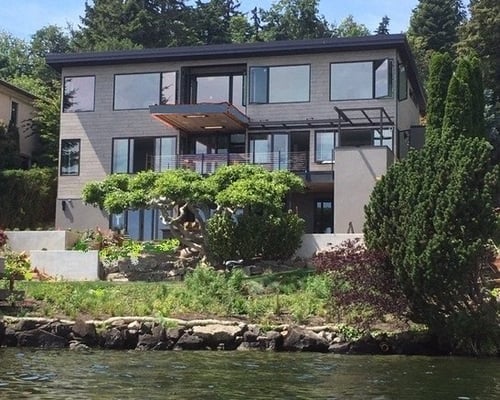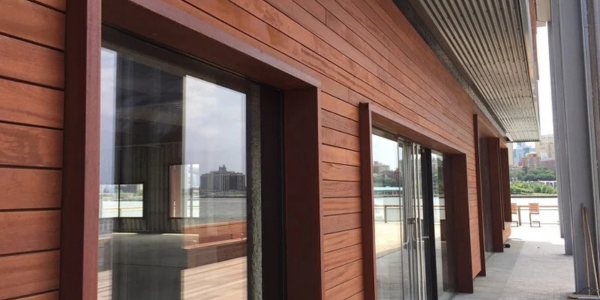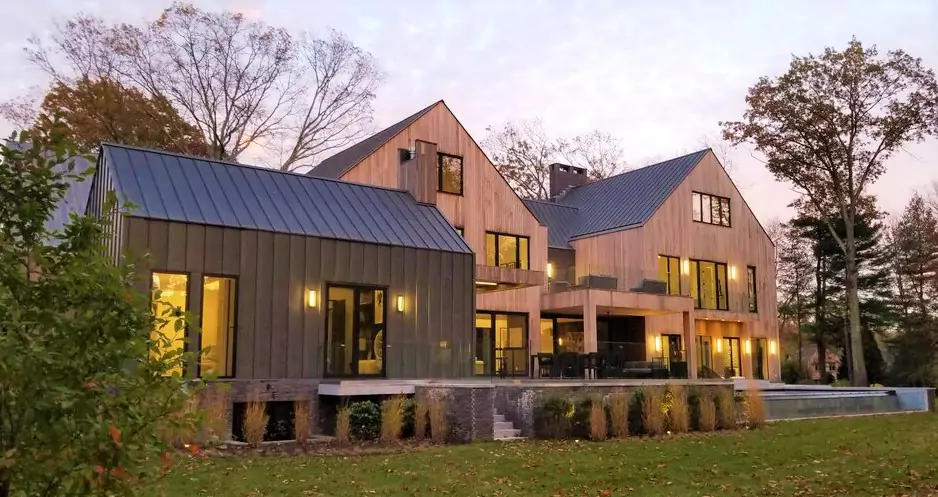
Wanting to perfect your home's curb appeal with the natural warmth and character of real wood siding? With a variety of wood siding options available, selecting the right one can seem never ending. This guide will help you navigate your choices by focusing on five key questions to consider, comparing popular wood siding types in terms of durability, longevity, and aesthetic appeal.
 Ipe wood siding installed vertically for a barn-style home design
Ipe wood siding installed vertically for a barn-style home design
Siding Your House: A Major Decision
If you are shopping wood siding, you know there are many types to choose from. Besides price, what's the difference? They can be significant: sustainability, degree of durability, long-term performance, and ease of maintenance to name a few. These will vary greatly by natural wood species.
The most popular types of wood siding are cedar wood siding, thermally modified wood siding, and hardwood siding. We will compare the these wood categories, the species and discuss how installation system can affect their longevity.
Choosing Your Wood Siding
Questions you might want to ask about wood siding materials that you are considering:
1. Wood Siding Aesthetics: Do you prefer the natural beauty of real wood siding with its unique color and grain variations? Or do you envision painting or staining your wood siding a specific color for your home?
2. Wood Siding Maintenance: Will I need to regularly re-paint or refinish my wood siding to maintain its appearance and protect it?
3. How Does Wood Siding Weather: If I decide to allow my wood siding to weather naturally to a silver-gray patina, will it add extra maintenance?
3. Wood Siding Durability & Longevity: How long does wood siding typically last on a home? How durable is wood siding for a house against termites, mold, rot, and decay?
4. Cost Considerations for Wood Siding: What is the upfront investment of wood siding for my home? Is the upfront cost of wood rainscreen siding installation worthwhile for my home's wood siding?
5. Return on Investment (ROI) for Wood Siding: Will I see a significant ROI for my choice of wood siding in terms of long maintenance costs, minumum repairs, and lasting curb appeal?
6. Wood Siding Sustainability: What types of wood siding are environmenally friendly? Which are responsibly harvested?
Quick Comparison Chart of Popular Wood Siding Materials

Discover the secrets to choosing the perfect wood siding materials for your project.
Get our free guide now.
Cedar Wood Siding
Cedar is a naturally beautiful, softwood siding material. Softwoods have naturally lower fiber density and higher moisture content than hardwoods do. Cedar siding is available as shingles, shakes, beveled clapboard, and siding boards. For a more sustainable design, cedar siding boards are often installed in a wood rainscreen system.
-
Cedar Shingles and Shakes
Red Cedar and White Cedar shingles have been popular for centuries. Cedar shingles and shakes offer a charming ‘cottagey’ style appearance. You can allow cedar shingles to weather to a silvery coastal gray appearance. Or you can paint or stain your cedar shingles to match your design palette. Painted cedar shingles last longer than weathered shingles.
-
Cedar Clapboard Wood Siding
Western Red Cedar clapboard has been a popular choice in siding for decades. Cedar clapboards have a cleaner, more formal look than cedar shingles. Cedar clapboard may be painted or stained, too, for better looks and a longer life.
-
Western Red Cedar Board Siding
Western Red Cedar boards are another wood siding option to consider. Cedar siding boards are thicker and stronger than shingles, shakes and clapboards. For a healthier home or building, cedar siding boards may be incorporated into a rainscreen design.
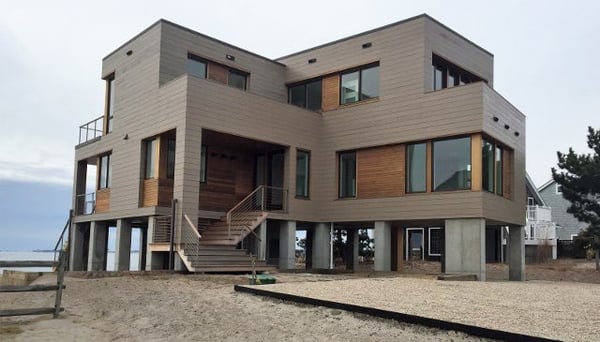 Classic cedar wood siding on a beachfront home installed with a rainscreen system.
Classic cedar wood siding on a beachfront home installed with a rainscreen system.
Because a wood rainscreen siding system creates a passive insulation layer, your home will ‘breathe’ better and dry out quickly, an important consideration with softwood siding material. A properly installed wood rainscreen system will add years of life to your siding and your home. Learn more about many added benefits of the Climate-Shield Rainscreen system here.
Because a wood rainscreen siding system creates a passive insulation layer, your home will ‘breathe’ better and dry out quickly. A properly installed wood rainscreen system will add years of life to your siding and your home.
Learn more about the Climate-Shield Rainscreen system, click here.
For more facts about the benefits, check out "Understanding Wood Rainscreen Siding Systems".
Things you may want to know about cedar siding:
Cedar is a softwood siding species. The ‘red cedar’ people and the ‘white cedar’ people can argue all they want about whether red cedar or white cedar is better. But neither side can refute that Western Red Cedar siding lasts longer than White Cedar. And thermally modified wood lasts longer than cedar.
- Cedar is a naturally beautiful, real wood siding material
- Most of the Western Red Cedar available today is a range of reds, light browns, and medium browns, usually with a knotty grain.
- Clear grade cedar is much harder to find than in the past.
- Availability of Western Red Cedar is inconsistent, and when it is, prices are higher than ever.
- Softwood siding material like Red Cedar are more susceptible to rot, decay and insect damage.
- Western Red Cedar has an expected lifetime use of about 10 years unless you paint it or stain it.
- For maintenance, cedar siding must be repainted or re-stained as needed, for good looks and longer life.
Get the latest copy of the "Residential Rainscreen Wood Siding Projects Portfolio",
with lots more inspiration and information.

Because of its durability, Thermally Modified Wood was used for the wood siding and wood decks at this home.
Thermally Modified Wood Siding
Thermally modified wood is an amazing wood siding option to consider. Non-modified softwood sidings like cedar, spruce, fir, and others will eventually rot even with the best of care. It’s a scientific fact.
That’s why scientists started a quest to make softwood siding more rot resistant and more insect resistant. Through trial and error, and years of scientific testing, they found a simple solution. If you cook out the sugars, the insects won’t eat it, and neither will fungi.
That’s why thermally modified wood siding is so rot resistant and insect resistant. Thermally modified wood siding is remarkably stable, too. Thermally modified wood expands and contracts less than non-modified wood.
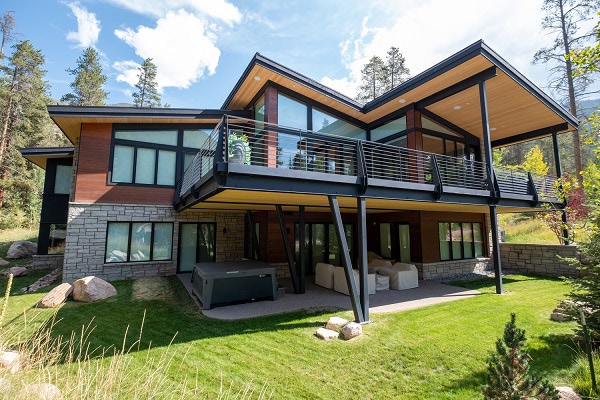 ThermaWood Hem-Fir siding and soffits shown on the rear facade of a contemporary home.
ThermaWood Hem-Fir siding and soffits shown on the rear facade of a contemporary home.
Thermally Modified Wood Siding
For some softwoods, like Western Hemlock, a vacuum kiln is used in a patented process. In the vaccuum kiln, the wood siding lumber is treated h lower heat and high pressure to cook out the sugars and remove moisture.
The result is a beautiful, high performance wood siding than is beautiful, harder, and more durable, with features that can be compared to hardwoods.
 Therma Wood Thermally Modified Hem-Fir siding on a mountain home blends wonderfully surroundings.
Therma Wood Thermally Modified Hem-Fir siding on a mountain home blends wonderfully surroundings.
Learn more about Therma Wood Thermally Modified Hemlock exterior siding here.
Check out the Siding Photo Gallery of Therma Wood Thermally Modified Hemlock Rainscreen projects for more ideas.
Things you may want to know about thermally modified wood siding:
- Thermally modified wood siding is a beautiful real wood siding option
- Thermally modified wood siding can be painted or stained with appropriate finishes.
- Colors of thermally modified are a little darker, and more uniformly colored, than the original non-modified wood.
- Thermally modified wood siding is exceptionally stable and durable. Resistant to rot, decay, and insects.
- Thermally modified wood siding boards can be installed traditional or in a wood rainscreen assembly.
- Thermally modified wood siding can last for 25 years, and even longer with occasional re-finishing
- Thermally modified wood siding has low life cycle costs and a high return on investment.
We made a free resource for you,
the "Ultimate Guide to Wood Rainscreen Siding". Download now.
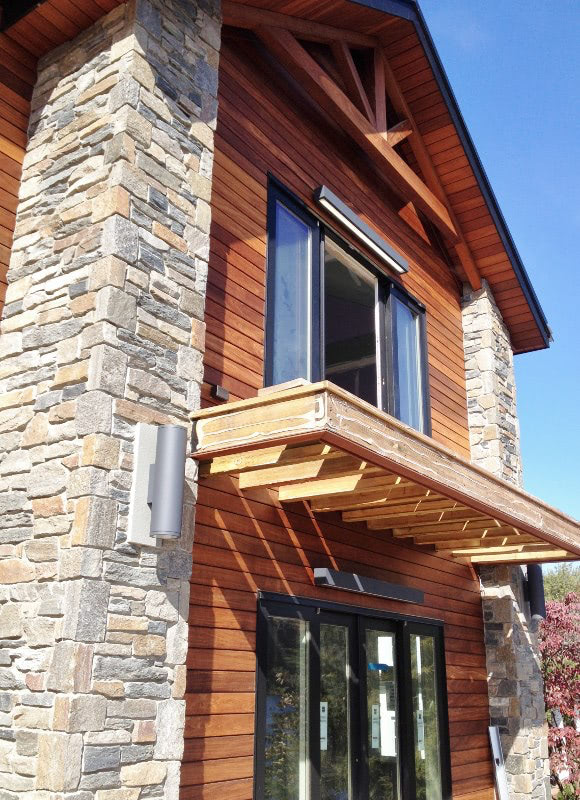 Ipe wood siding contrasts with stone accents on an exterior entryway
Ipe wood siding contrasts with stone accents on an exterior entryway
High Density Hardwood Siding
High density tropical hardwoods may be used to create very high-performance wood siding. There are several species that offer a mix of beauty, exotic looks, strength, and durability. Jatoba, Machiche, Ipe, Garapa and Cumaru wood sidings are excellent options to consider.
Although there are many different hardwood siding species to consider, here are a few things they all have in common:
- High density hardwood is a beautiful, real wood siding option
- High density hardwood cannot be painted - it is too dense.
- For a richer look, hardwood siding can be sealed with an oil base finish such as Penofin Hardwood Formula or a similar finish.
- Hardwood siding is so durable, you can allow it to weather to a silvery gray patina without harming it.
- It varies by wood species, but hardwoods are more exotic in appearance and exhibit lots of color variations and lots of tropical grain patterns.
- Hardwood siding is very resistant to rot, decay, and insects.
- Mataverde hardwood siding is covered by a 25 year limited warranty.
- Hardwood siding boards can be installed traditionally or in a wood rainscreen assembly.
- Hardwood siding has the lowest life cycle costs, and offer a high return on your investment.
View the Rainscreen Siding Photo Gallery here for more hardwood siding designs.
For more about your Wood Rainscreen Siding options, click here.
Jatoba Wood Siding
- Jatoba has warm pink and cherry tones with a coarser grain.
- Jatoba is a comparable alternative to the look of Ipe wood siding at a lower price.
- Jatoba hardwood is extremely strong and resistant to decay.
- Jatoba has a 25+ year usable lifetime.
- Jatoba wood siding can be installed traditionally or in a wood rainscreen assembly.
- The natural high density of Jatoba makes it highly resistant to moisture damage and decay.
- Jatoba can be sealed with a UV protectant oil-based finish.
 Jatoba hardwood rainscreen siding installs easily and beautifully around windows and doors.
Jatoba hardwood rainscreen siding installs easily and beautifully around windows and doors.
Learn more about Jatoba Hardwood Rainscreen Siding, click here.
Visit the Jatoba Rainscreen Siding Photo Gallery here for more Jatoba wood siding examples.
There's more to see in the "Residential Rainscreen Projects Portfolio".
Download your copy now.
Garapa Wood Siding
- Garapa has natural golden brown to amber tones and exotic figuring.
- Garapa hardwood is extremely strong and resistant to decay, rated about two times tougher than Oak.
- Garapa wood siding can be installed traditionally or in a wood rainscreen assembly.
- The natural high density of Garapa makes it highly resistant to insect damage and decay.
- Garapa has a 25+ year usable lifetime.
- Garapa can be sealed with a UV protectant oil-based finish.

Garapa hardwood siding installed vertically on a modern colonial home exterior.
Learn more about Garapa Hardwood Rainscreen Siding, click here.
Check out the Garapa Rainscreen Siding Photo Gallery here for more Garapa wood siding images.
FSC Machiche Wood Siding
- Machiche has rich, chocolatey brown tones with exotic graining.
- Certified by the Forest Stewardship Council as sustainably harvested (learn about FSC Certification here).
- Machiche wood siding can be installed traditionally or in a wood rainscreen assembly.
- Machiche has a 25+ year usable lifetime.
- Machiche can be sealed with a UV protectant oil-based finish.
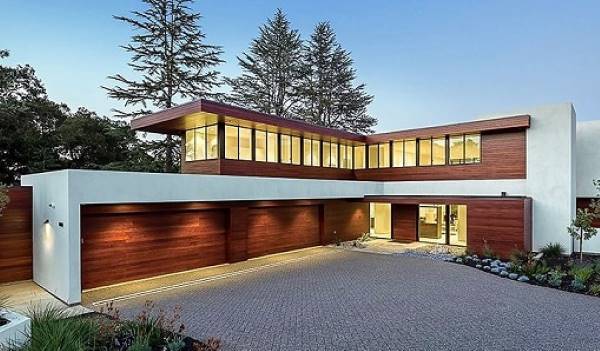 Machiche wood rainscreen siding elevates the exterior of this modern custom home.
Machiche wood rainscreen siding elevates the exterior of this modern custom home.
Learn more about Machiche Hardwood Rainscreen Siding, click here.
Check out the Machiche Rainscreen Siding Photo Gallery here for more Machiche wood siding images.
Looking for more wood siding ideas? Check out the "Residential Rainscreen Wood Siding Portfolio"
for additional photos and case studies. Download now.
Cumaru Wood Siding
- Cumaru has varied reddish-brown colorations with interesting grain patterns.
- Coarse grain with lots of tropical variations
- Cumaru wood siding can be installed traditionally or in a wood rainscreen assembly.
- Cumaru has a 25+ year usable lifetime.
- Cumaru can be sealed with a UV protectant oil-based finish.

Random lengths of Cumaru and both vertical and horizontal rainscreen installation shows off the natural colors.
Learn more about Machiche Hardwood Rainscreen Siding, click here.
Check out the Machiche Rainscreen Siding Photo Gallery here for more Machiche wood siding images.
Now sure how to choose for your next wood siding project? Download a free copy of the
Ipe Wood Siding
- Ipe wood siding boasts warm brown tones and exotic graining.
- Ipe hardwood is the standard all other wood siding materials are compared to, because of its incredible high fiber density and rugged strength.
- Extremely resistant to insect damage, rot, and decay.
- Ipe has a 25+ year usable lifetime.
- Ipe wood siding can be installed traditionally or in a wood rainscreen assembly.
- Ipe can be sealed with a UV protectant oil-based finish.
- If allowed to naturally weather to a silver gray patina, no additional finish is needed.

An Ipe wood rainscreen siding exterior warms the feel of a cool stone deck and pool.
Read more about Ipe Hardwood Rainscreen Siding, click here.
Check out the Ipe Rainscreen Siding Photo Gallery here for more Ipe wood siding images.
We hope you found this article helpful. Choosing the right wood siding material will make, and keep your home exterior the best looking on the block. If you still need help, contact our specialists for samples, pricing, and more guidance. We are here for you.

Related Posts
